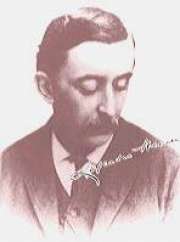|
Biografie Lafcadio Hearn
Patrick Lafcadio Hearn (27 June 1850 - 26 September 1904), also known as Koizumi Yakumo (СÈȘ°Ëë…?) after gaining Japanese citizenship, was an author, best known for his books about Japan. He is especially well-known for his collections of Japanese legends and ghost stories, such as Kwaidan: Stories and Studies of Strange Things.
Hearn was born in Lefkada (the origin of his middle name), one of the Greek Ionian Islands. He was the son of Surgeon-major Charles Bush Hearn (of County Offaly, Ireland) and Rosa Antonia Kassimati, who had been born on Kythera, an island in the Myrtoon Pelagos (currently in the municipality of Athens). His father was stationed in Lefkada during the British occupation of the islands. Lafcadio was initially baptized Patricio Lefcadio Tessima Carlos Hearn in the Greek Orthodox Church. It is not clear that Hearn's parents were ever legally married, and the Irish Protestant relatives on his father's side considered him to have been born out of wedlock. (This may, however, have been because they did not recognize the legitimacy of the Greek Orthodox Church to conduct a marriage ceremony for a Protestant.)
Hearn moved to Dublin, Ireland, at the age of two, where he was brought up in the suburb of Rathmines. Artistic and rather bohemian tastes were in his blood. His father's brother Richard was at one time a well-known member of the Barbizon set of artists, though he made no mark as a painter due to his lack of energy. Young Hearn had a rather casual education, but in 1865 was at Ushaw Roman Catholic College, Durham. He was injured in a playground accident in his teens, causing loss of vision in his left eye.
In 1890, Hearn went to Japan with a commission as a newspaper correspondent, which was quickly broken off. It was in Japan, however, that he found his home and his greatest inspiration. Through the goodwill of Basil Hall Chamberlain, Hearn gained a teaching position in the summer of 1890 at the Shimane Prefectural Common Middle School and Normal School in Matsue, a town in western Japan on the coast of the Sea of Japan. Most Japanese identify Hearn with Matsue, as it was here that his image of Japan was molded. Today, the Lafcadio Hearn Memorial Museum and his old residence are still two of Matsue's most popular tourist attractions. During his 15-month stay in Matsue, Hearn married Setsu Koizumi, the daughter of a local samurai family, and became a naturalized Japanese, taking the name Koizumi Yakumo.
In late 1891, Hearn took another teaching position in Kumamoto, Kyushu, at the Fifth Higher Middle School, where he spent the next three years and completed his book Glimpses of Unfamiliar Japan (1894). In October 1894 he secured a journalism position with the English-language Kobe Chronicle, and in 1896, with some assistance from Chamberlain, he began teaching English literature at Tokyo (Imperial) University, a post he held until 1903. In 1904, he was a professor at Waseda University. On September 26, 1904, he died of heart failure at the age of 54.
Glimpses of Unfamiliar Japan (1894)
Out of the East: Reveries and Studies in New Japan (1895)
Kokoro: Hints and Echoes of Japanese Inner Life (1896)
Gleanings in Buddha-Fields: Studies of Hand and Soul in the Far East (1897)
Exotics and Retrospectives (1898)
Japanese Fairy Tales (1898) and sequels
In Ghostly Japan (1899)
Shadowings (1900)
Japanese Lyrics (1900) - on haiku
A Japanese Miscellany (1901)
Kott¨: Being Japanese Curios, with Sundry Cobwebs (1902)
Kwaidan: Stories and Studies of Strange Things (1903) (which was later made into the movie Kwaidan by Masaki Kobayashi)
Japan: An Attempt at Interpretation (1904; published just after his death)
The Romance of the Milky Way and other studies and stories (1905; published posthumously)
|





